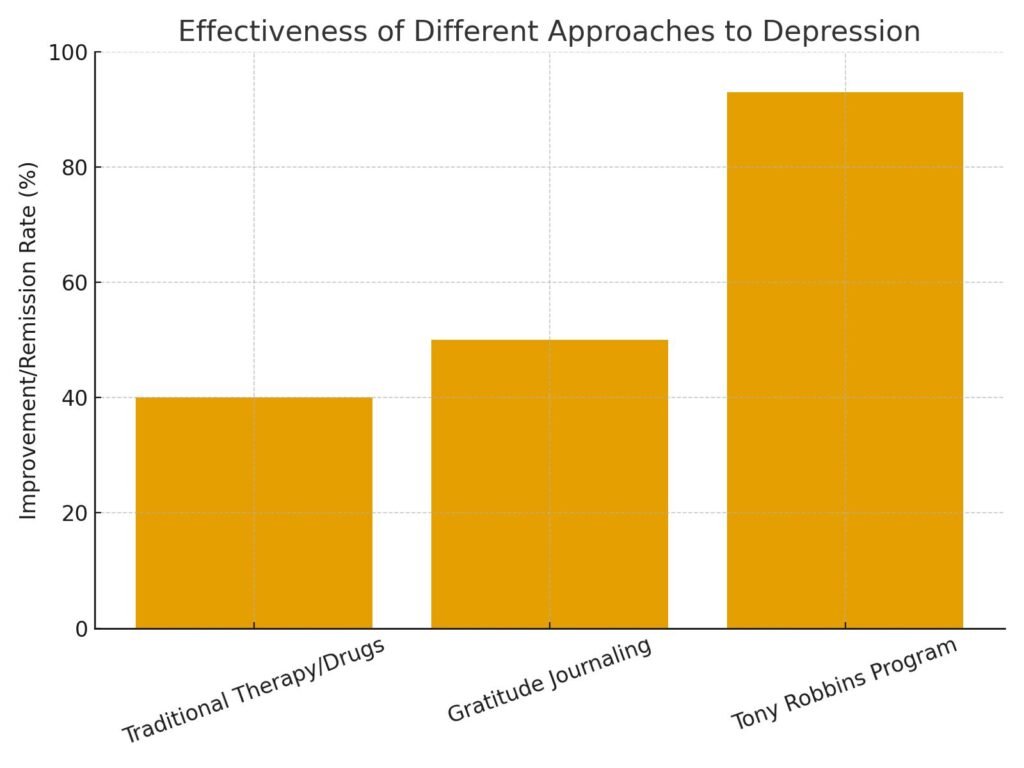Rewire Your Brain - Unlock Motivation, Beat Depression, and Create Lasting Change
The Dr. Jordan B. Peterson Podcast with Tony Robbins | September 21, 2025
In today’s fast-paced and high-pressure world, millions of people find themselves battling stress, anxiety, and even depression. Many turn to traditional methods like medication, counseling, or therapy, and while these treatments help a large number of people, they don’t always lead to lasting results. Side effects, inconsistent progress, and reliance on external solutions can make the journey even harder. But here’s the exciting news—you can actually rewire your brain naturally by tapping into neuroscience and psychology-backed strategies that change how you think, feel, and act.
World-renowned psychologist Jordan Peterson and personal development legend Tony Robbins have been exploring this very topic. Their insights reveal why some people are able to transform their lives dramatically—breaking free from depression, reigniting their passion, and creating lasting success—while others stay stuck in negative cycles.
The key difference often lies in learning how to rewire your focus, energy, and motivation systems. This blog will break down their powerful discussion into clear takeaways you can use today. You’ll learn why your aim determines your reality, how to move from willpower to true motivation, and how clinical studies prove non-drug interventions can dramatically improve mental health.
By the end, you’ll have a toolkit of practical steps to raise your energy, shift your focus, and create a compelling future that naturally pulls you forward.

The Science of Focus: You See the World Through Your Aim
One of the first and most profound insights is this: we don’t experience life—we experience the life we focus on. Your brain doesn’t process reality in a neutral way. Instead, it filters your experiences based on what you’ve set your sights on.
Think about when you buy a new car. Suddenly, you see that same model everywhere. Did the number of those cars increase overnight? Of course not. What changed was your brain’s focus. Your aim becomes a lens that determines what you notice, what excites you, and even what opportunities you’re able to recognize.
From a neuroscience perspective, this happens because dopamine—the brain’s motivation and reward chemical—is released when you move toward meaningful goals. Without an aim, your brain doesn’t fire up that system, leaving you unmotivated and emotionally flat. With a goal, your emotional system lights up: obstacles register as challenges to overcome and small wins feel exhilarating.
Practical Tip: Grab a notebook and write down one meaningful aim for the next 90 days. Keep it visible. Every time you face an obstacle, remind yourself: “This challenge is part of the pathway.” Notice how your brain begins to shift from seeing problems to identifying opportunities.
Why a Compelling Future is Everything
If there’s one secret to resilience, it’s this: anyone can endure a hard today if they have a compelling tomorrow.
Many people who feel stuck, anxious, or depressed suffer not from laziness or weakness, but from a lack of vision. Without a future worth moving toward, the present feels heavier and harder. Robbins emphasizes that it’s not enough to have a vague goal—you need a future that genuinely excites you and aligns with your deepest values.
A weak goal might be: “I want to lose weight.” A compelling future sounds more like: “I want to become fit so I have the energy to play with my kids, enjoy adventures, and live long enough to see my grandchildren grow up.” The difference? One is a task. The other is a vision tied to purpose and emotion.
History proves this truth. John F. Kennedy didn’t just say, “We want stronger technology.” He declared: “We choose to go to the moon in this decade.” That vision was compelling enough to unite an entire nation and drive an extraordinary leap forward in science and innovation.
Practical Tip: Ask yourself: What future would excite me so much that I’d fight through discomfort to achieve it? Write a vision statement that goes beyond surface goals. Tie it to family, contribution, growth, or meaning. That emotional connection is what fuels perseverance.
Push Motivation vs Pull Motivation
Robbins makes a powerful distinction that can completely change the way you see motivation: push motivation versus pull motivation.
- Push Motivation is what most people rely on. It’s when you force yourself through willpower and discipline. It works in short bursts—like dragging yourself to the gym or pushing to finish a deadline—but it’s exhausting. Willpower runs out, and when it does, motivation collapses.
- Pull Motivation is when you’re drawn forward by a vision so meaningful that you don’t need to force yourself. Instead of asking, “How do I make myself do this?” you feel naturally pulled into action because the goal is aligned with your deepest values and desires.
The truth is, pull always beats push. Why? Because it bypasses resistance. Think of a parent staying up all night with a sick child. That’s not willpower—it’s love and purpose pulling them forward. That’s why people who connect their goals to something bigger than themselves often achieve what others can’t.

Practical Tip: Review your current goals. Are you pushing yourself out of obligation, or are you pulled by passion and purpose? If it feels like push, ask: What deeper reason would make this exciting instead of exhausting?
Rewiring Depression: What the Clinical Trials Proved
Here’s where Robbins’ work becomes not just motivational but scientifically validated. Unlike most personal development programs, Robbins actually put his methods through a clinical trial, published in the Journal of Psychiatry.
During COVID-19, researchers compared three groups:
- Participants in Robbins’ six-day immersive program + 30 days of exercises.
- People practicing gratitude journaling, a proven psychological tool.
- People receiving traditional treatments (therapy/medication).
The results were staggering:
- Traditional treatments: Only around 40% improved, and many needed long-term medication.
- Gratitude journaling: About 50% reported benefits, showing that focusing on positives helps.
- Robbins’ program: An incredible 93% remission rate within 6 weeks—with long-term benefits still present a year later, including reduced suicidal thoughts and higher engagement in life.
This isn’t hype—it’s peer-reviewed evidence that rewiring the brain through focus, energy, and immersive experiences can outperform medication and therapy in certain cases.

Key Takeaway: Depression isn’t always a lifelong sentence. By changing the way you experience focus, energy, and meaning, it’s possible to eliminate symptoms and build emotional resilience—without relying solely on drugs.
Energy = Emotion = Lasting Change
Another central idea is that your emotional state determines your behavior more than strategy ever will. You can have the perfect plan, but if you’re in a low-energy state, you’ll procrastinate, self-doubt, and sabotage your progress.
When energy is low, negative thoughts multiply, cortisol rises, and even small problems feel overwhelming. But when energy rises—through movement, music, deep breathing, or exercise—your brain chemistry flips. Dopamine and testosterone rise, stress hormones drop, and suddenly, possibilities open up.
Robbins calls this priming: deliberately shifting your state before tackling challenges. The science backs it up. In fact, research shows that even small energy-raising practices can boost focus, memory, and learning. That’s why athletes, musicians, and top performers all have rituals to prime themselves before performing.
Practical Tip: Try this quick state-shift: put on your favorite upbeat song, stand tall, and take five deep, powerful breaths. Notice how quickly your mental state shifts from sluggish to energized. Do this before important meetings, workouts, or tasks.
Experience Beats Belief
“A belief is a poor substitute for an experience.”
Knowing something intellectually doesn’t create change. Experiencing it does. For example, you can read about gratitude all day, but until you actually practice it daily and feel the shift in your emotions, it won’t stick.
That’s why Robbins’ events are immersive—12+ hours a day for multiple days. The sheer intensity creates repetition and emotional anchors that rewire the nervous system. Once you’ve experienced what’s possible in your own body, it’s far more powerful than just believing it could happen.
The same principle applies to mastery in any field. Steph Curry didn’t become the world’s best three-point shooter by believing he could. He took 500 shots every single day, building neurological wiring that made success automatic. Experience + repetition is what locks transformation in place.
Practical Tip: Instead of just reading self-help books, turn ideas into action. Pick one habit and commit to practicing it daily for 30 days. Experience transforms information into identity.
Prime Yourself Daily
Much of what we think is “our decision” is actually influenced by our environment through priming. The brain picks up subtle cues and adjusts behavior unconsciously.
For example:
- In one study, people holding a warm coffee described strangers as “warm,” while those holding iced coffee described the same strangers as “cold.”
- Simply seeing the Apple logo before a creativity test improved test scores by 22% because of the association with “think different.”
If your environment can unconsciously shape your mood and choices, you can flip the script and deliberately prime yourself every day.
Practical Tips to Prime Your Day:
- Start with gratitude: List 3 things you’re thankful for before touching your phone.
- Move your body: Even 5 minutes of stretching or walking can reset your brain chemistry.
- Set your aim: Ask, “What’s my number one outcome today?” Focus directs your perception.
- Use music strategically: Create playlists for focus, calm, or energy, and let sound prime your state.
By making priming a daily ritual, you train your brain to expect positivity, focus, and energy.
How to Create Pull Motivation in Your Life
So how do you go from forcing yourself into action to being pulled effortlessly by your goals? Robbins suggests a five-step process anyone can apply:
- Clarify Your Aim – Define a vision that excites you. Imagine your life 5 years from now if everything went right. Choose something that lights you up emotionally, not just logically.
- Find the Reasons – Surface goals fade quickly. Real motivation comes from asking “why.” Want money? Is it for freedom, security, contribution, or family? Reasons are stronger than objects.
- Model Success – Success leaves clues. Instead of trial and error, find people who’ve achieved what you want and study their strategies. Adapt what works to your life.
- Resolve Inner Conflicts – Many people fail because their values clash. For example, wanting success but fearing judgment. Re-engineer your values so they pull you in the same direction.
- Immerse Yourself – Growth requires immersion, not one-off inspiration. Repetition, practice, and community make change stick. Attend workshops, surround yourself with growth-oriented peers, and repeat new habits until they’re automatic.
Practical Tip: Choose one area of your life—health, relationships, or career. Apply all five steps. For example, instead of “I want to lose weight,” aim for “I want to have energy to travel with my family.” Find reasons, model someone fit, resolve limiting beliefs, and immerse in fitness culture.
Conclusion: Your Brain is Waiting to be Rewired
The most empowering truth of modern neuroscience is this: your brain is not fixed—it’s plastic. That means you can change its wiring through focus, energy, repetition, and purpose. You don’t have to remain stuck in old patterns, low moods, or limiting beliefs.
Whether you’re struggling with depression, feeling unmotivated, or aiming for extraordinary success, the formula is clear:
- Have a compelling aim. It directs your perception and creates positive emotion.
- Fuel it with pull motivation. Connect your goals to love, contribution, or meaning.
- Prime your state daily. Small rituals rewire your energy and emotions.
- Immerse yourself in experience, not just belief. Repetition and action create mastery.
As Robbins reminds us: “We don’t experience life. We experience the life we focus on.” So the question becomes—what will you choose to focus on today?
Because your brain is ready. It’s waiting for you to direct it. And once rewired, it has the power to unlock resilience, joy, and achievement beyond anything you’ve imagined.
Related Post


